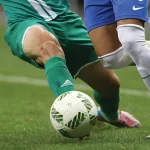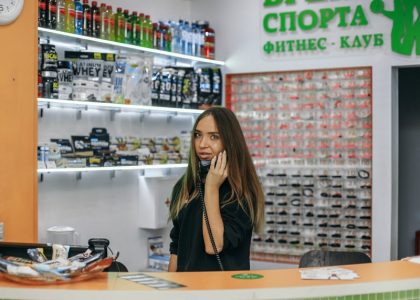How to remove fleas from chickens? Specific steps for treatment and prevention. Effective recipes for removing fleas
Flea remedies for chickens
Fleas parasitize many types of warm-blooded animals and humans. Chickens are also attacked by these insects. On large poultry farms, parasites usually do not survive – this is due to the cyclical production, good sanitary preparation of buildings and measures to prevent the introduction of infections and invasions into the farm.
But in small farms, fleas feel quite at ease.
Promotes reproduction:
- warm season;
- high ambient temperature;
- lack of regular disinfection and cleaning of the poultry house;
- accumulation of debris on the floor;
- rare change of bedding;
- and poor condition of the nests.
Harm inflicted
Fleas feed on the blood of chickens. If the number of parasites is low, the problem is the disturbance caused to the bird. Bites are very painful, their saliva contains substances that irritate the skin. Chickens constantly sort out feathers with their beaks, they can pull them out, comb itchy places.
Damaged skin is seeded with bacteria, and inflammation develops.
Biology of parasites
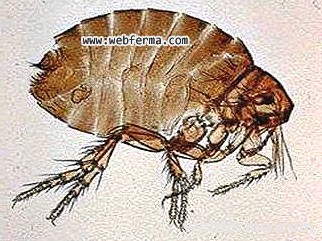
They are quite specific to the choice of the owner. For agriculture, six species are important, of which only one is able to parasitize birds – Echidnophaga gallinacea. There is also Ceratophyllus niger, a western chicken flea that parasitizes birds and humans; and C.gallinae, the European chicken flea that only infects birds. However, the last two species are rare in Russia.
The parasite is a small wingless insect covered with chitinous plates. The size of an adult is about 1.5 mm, the body is laterally flattened, and has six legs. The rear pair is well developed and allows the insect to jump 1-1.5 meters.
They have a well-developed piercing-sucking apparatus, with the help of which the skin is pierced and blood is drunk.
Their eggs are oval, white, about 0.5 mm long. The female forcefully throws them out of her body, spreading them over the bedding and other objects. After 5-60 days, depending on temperature and humidity, larvae 3-5 mm long emerge from the eggs. They can be found in bird nests or droppings.
The larvae feed on the secretions of adult fleas and dead organic matter. After three molts, the larvae pupate, and after a while an adult flea is born.
Eggs and pupae are resistant to conventional insecticide treatments that are used to control fleas in chickens, so treatments should be carried out 2-3 times with an interval of 10-14 days. Recall that in the hot season, the development cycle is shortened, this must be taken into account when planning treatments.
Symptoms of the disease
Finding fleas on a chicken is easy enough. They accumulate on areas of the skin devoid of feathers, more often on the head and neck. Tightly adhering to the bird's body, they look like small brown moles.With a careful inspection, you can see parasites in the nests, and also detect their eggs and white larvae.
An indirect feature is a loss of a bird of a pen, combing bumps, anxiety and constant hooping – cleaning feathers.

The photo shows a flea, dug in the skin of the chicken. They are perfectly visible to the naked eye.
Measures of struggle
Get rid of fleas in chickens rationally with the help of special drugs against insects – insecticides.
What means to apply
Currently, drugs of these groups are produced to destroy:
- Phosphorian compounds – phos.
The most famous are: chlorofos, carboofos, trichloromethos, neocidol (diazine). - Chlororganic compounds – HOS.
The most popular – hexahloran. - Carbamata
Sevin. - Pyretride
Neostomasan, butoxy (deltamerin), entomasan (cypermethrine), permethrin
Pyrethroids belong to the new generation of insect funds. They are practically safe and rarely cause side effects. They are widely used to destroy fleas in cats and dogs.
The most famous Pyrethroids 3 generations
- Flucitrinate;
- Fenprofatrine;
- tramometrine;
- Cigalotrin;
- cycloprotrin;
- digitrine;
- Bifetrin;
- This isphenfrox;
- flounded.
Concentration of solutions
The solutions of the preparations for the treatment of birds are used in the following concentration.
- 0.25% neocidol;
- 3% Water emulsion Sevin;
- Butoxos, non-massan, entomozan in dilution 1: 1000.
- 1% aqueous solution of chlorofos;
- 0.5% carbofos emulsion;
- 0.5% trichlorometaffos-3 solution;

1 liter of butoxes costs about 5 thousand rubles (at spring prices 2016). For processing from chicken fleas, it is necessary to dissolve 250 ml per 1,000 liters of water.
Spraying birds
Processing is carried out by spraying the chickens from the sprayer (sprayer). Evenly moisturize the plumage, while whenever possible avoid getting medicine in the eyes and nose. When working, use the protection means – marlevant bandage and rubber gloves.
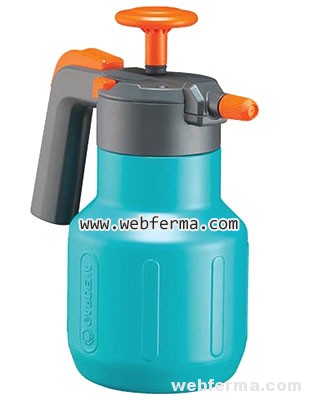
For disinfection of a small chicken coop, a usual hand-made garden sprayer is suitable.
Powders sprinkle each chicken individually and rubber in the skin:
- 2% Dust Sevin;
- Dust Pyrethrum;
- Powder Deltametrina.
You can also use drops to the withers for dogs and cats. They are sold in pet stores. They should be applied according to the dosage by the weight of the bird. In the pipette there is an insecticide oil solution, it must be squeezed directly on the skin in the area of the rear surface of the neck – where the bird will not be able to shove it.
Within 12-24 hours, the insecticide will spread through the body and all the symptoms will disappear. Used Dana's drops, "Bars", "Advantaj", "Chisthel", "Frontline" and others.
Room processing
After processing the bird, you need to disinfect the chicken cookebed. Birds are removed from the room. The old litter and the nest material is sprayed with a solution of insecticide, withstand 2-3 hours and emit. It is necessary to destroy fleas, and they did not apply from garbage.
Then once again handle the entire poultry line by spraying. Recall that the accumulations of garbage in the room are unacceptable – it creates favorable conditions for the reproduction of parasites.
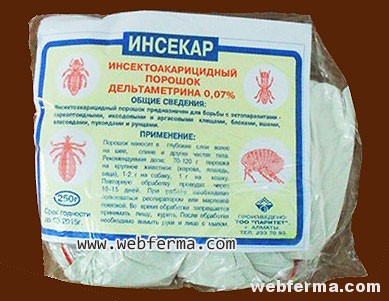
In the photo – packaging of delatmerine powder for the treatment of rooms on a farm against fleas.
For disinsection of the chicken coop used
- Pyrethrum – 10% water suspension;
- 0.25% Water emulsion Sevin;
- 0.5% water emulsion carbofos;
- "Baitex";
- "Baigon";
- "Solfak" in dilution 1: 100 – 1: 400.
The solution consumption depends on the drug, but on average is 100 ml per m2 of the treated surface (gender and wall). Read carefully instructions before applying!
You can use the means of household chemicals to destroy insects (fleas, cockroaches, bedbugs) and ticks. Liquid solutions in bottles – "Tetrix", "Get", "Kukaracha", "Fufanon". Their cost will be slightly higher than that of pyrethroid animals.
After processing drugs against chicken fleas, the room is kept with a closed minimum of 4 hours, and is better than a day. Then the chicken coop is ventilated, and the feeders and drinkers are rinsed with water. Walking processing is optional, because the fleas inhabit in warm and wet places.
In the hot season for the prevention, the condition of sandy baths is monitored and regularly dried with grass, remove trash from the yard.

Especially thoroughly handle from flea follows the angles of the chicken coop.
Fleas can be saved for a long time in an external environment, so it will take re-processing in about 2 weeks.
Folk remedies
To scare the fleas and other parasite insects, you can sprinkle in the chicken coop of brooms from a pyrhem or wormwood. I do not like insect smell of potato and tomato tops, geranium and lavender.









